A good holiday is one that is spent among people whose notions of time are vaguer than yours ~ J. B. Priestley. I smiled as I read this and thought about my weekend holiday at Kashid.
Despite being close to both Pune and Mumbai, Kashid remained undiscovered and ignored for a long time, just a small fishing village. A few years ago, the quiet beach suddenly found world-weary holiday makers rushing towards it every weekend, and it responded by remaining isolated and laidback. Thankfully, for it still remains an ideal relaxing break for those seeking to get away from it all – and not carrying it all with them.
We reach Kashid late one Saturday morning, stopping on the way for tea and snacks and general directions. A late and heavy lunch is followed by two hours in the shaded porch of the hotel under the coconut trees, looking at the sea in the distance, blue now, a shimmering white a few minutes later. I spend a pleasant and instructive afternoon, the book I have taken along lying opened and unread on my lap, eyes closed and trying to identify the bird calls. I admit I do not make much progress beyond the croaky kraws. Through eyes only half open, I spot my husband attempting to make friendly contact with the resident resort cat, giving up soon when the white and brown animal shows no interest in his affable advances. In all, I cannot think of a better way of spending a Saturday afternoon – the faint smell of the sea in the air, music on the ipod and no mobile phone and no laptop.
As the heat begins to ebb, we head to the beach at Kashid just a kilometer away on the narrow hill road. On the beach, the few shacks that display signs of cold drinks and oily snacks just right for an evening at the beach are all shut. I remark to my husband that the entire village must have gone to Mumbai for the long weekend to escape the heat and the crowds! He glares at me and keeps walking, looking down at the patterns his muddy wet feet make on the clear white sands, turning golden with the sunset colours.
This part of the beach is one noisy colorful playground. There are families playing cricket on the sand (my husband wanting desperately to join in), rules made and broken at will. As we watch, some of them take a break and bargain with the buggy-man for taking a ride into the sunset; others have found a Frisbee and are throwing it in the air, trying valiantly to catch it despite the strong wind that makes it seem as if the plastic Frisbee has a mind of its own.
There are touching declarations of love carved in the wet sand, transient messages washed away in an instant by the waves. Groups of shrieking teenagers run around, in and out of the waters, adding to the general chaos and noise. They stand on the water, looking for someone to take their photograph, capturing that transient moment of fun. Elsewhere, another group has started a game of antakshari, the noise level steadily increasing with more people joining in with their own versions of old Hindi film songs.
As it starts to get cooler, the beach shacks suddenly come alive. Tired children make their way to the tiny wooden swings along the road as their parents sit on the plastic chairs, sipping on coconut water and Cola, munching on hot pakoras. Some kind – and enterprising – soul has put up hammocks across the sandy stretch and they beckon alluringly. The next two hours pass by quickly on the hammock, watching the sun go down in the sea just a few feet away, feeling the gentle evening breeze on the face, listening to people all around discuss their jobs and busy city lives. It is totally dark by the time I step off the hammock; my spine has by then developed an abnormal curvature. The shacks are closing and the cars have all but left and the sky has switched on its lights – we step on to the beach for a few minutes looking up at the night sky, the stars that shy away from city lights are out in full force.
Driving to Murud on Sunday morning from Kashid, I have the sense of traveling back in time. Small sleepy hamlets dot the road all along the way, not fully awake but for the early morning fisher-folk on the roads. The children are all up though, learning to ride the bicycle, swinging dangerously in the middle of the lane. Herds of cattle are out grazing, looking bleary-eyed and surprised each time they hear the honk of a passing car. Most of this route is along the coast, the sea suddenly appearing at our side on the curves and then going off view till the next sharp turn.
We drive all the way through the village of Murud, stopping only to stare at the sea from high in the hills, just in front of the ornate palace of the Nawab and then for directions to get to the jetty for the Janjira fort. We reach Rajpuri from where the boats leave and see a sign at the entrance, happy new year 2006 and our sense of time travel is sharply enhanced; any year, this place would look and feel the same. We park the car and walk through small lanes to get to the jetty, young men calling out from tiny shop windows along the lane, “Bisleri, cold drinks, chai, nashta” and more shops selling Konicca colour film with cheerful disdain for all branding.
Janjira is a short boat-ride into the sea, the young man at the helm is reluctant to answer my numerous questions. He keeps imparting tantalizing little bits of information about the fort, withholding the rest; as we step into the fort, he turns around and says, let me be your guide.
So, guide and we walk though the purported twenty two acres of the awesome sea-fort, or what remains of it. There is an impressive rhythm about the history of this fort – twenty two years to build, twenty two acres, twenty two watch towers, each manned night and day by armed sentries. Additionally in the past, there were huge cannons at the ready and only three entrances, all cleverly concealed so they were not visible anywhere from the sea except from very close by. The enemy did not have a whiff of a chance.
The guide (and guidebooks) say that this fort built by Siddi Johar, head of the Siddi clan who moved to India all the way from Abyssinia, has never fallen to enemy hands – not the British, nor the Portuguese, not even the all-conquering Marathas. The fort was of strategic importance, given its place in the Arabian Sea, and there are several legends about rulers who tried and failed to take Janjira. The most interesting of these stories is about Sambhaji, the son of Shivaji, who even built a fort across the bay, at Kansa, and tried everything, including an underwater tunnel.
Some sources I read say that the fort was built around 1118, while others place it some time in the 16th century. Ismail, our guide also says that till as recently was 1972, people lived inside the fort – including his father who was born there. I have no idea about the veracity of this claim, but the fort does seem capable of supporting human life – mosques and a temple, a huge granary and two fresh water lakes right in the middle. The outer walls cemented by a mixture of lime, jaggery and lead have withstood centuries of the sea battering against them and the sun and rain.
There is a general air of neglect about the fort today; it is accentuated by the graffiti scrawls and the broken stone edifices all over. Despite that, the walls of the fort have several stories to tell, now drowned by the noise of the waves crashing against them. I would have loved to spend all day there under the shade of a tree, but the tide is rising and our guide-boatman is in a hurry to get back to land. The waters have covered two more steps by the time we get down to the boat. In his hurry, Ismail still stops to point out the insignia of the Siddis near the entrance of the fort, a tiger holding six elephants in its clutches – the might of the Siddis, the ajinkya, or indestructible.
General Information : Paramount Airways flies to Pune from large cities in the South including Chennai and Bangalore. From Pune, Kashid is 160 km away, just over four hours drive via Mulshi and Kolad. The drive on the expressway till Panvel and then on to Kolad on the Goa highway NH 17 is slightly longer but beautiful especially in the monsoons.
Stay : There are several resorts to choose from – at Kashid, stay at Kashid Beach Resort or more popular Prakriti Resort, or drive on to Murud and stay at the Golden Swan or Sea Shells Resort. Be sure to sample some of the local cuisine, including fresh vada-pav from the roadside snack vendors.
***
This piece appeared in the October issue of Windows & Aisles, the inflight magazine of Paramount Airways.


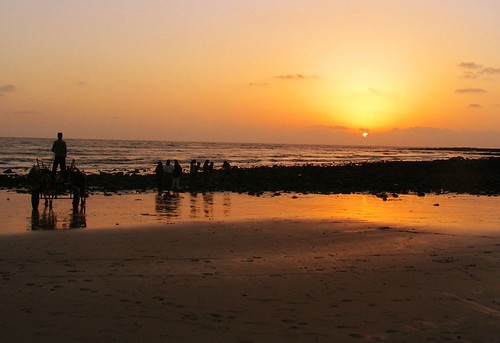
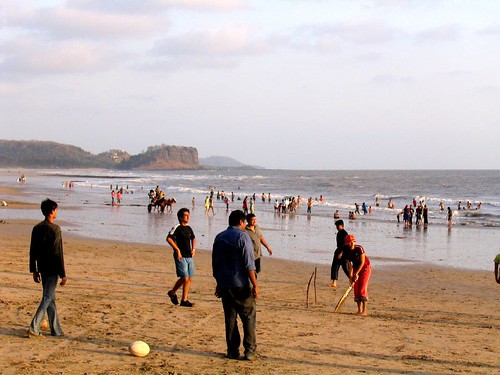
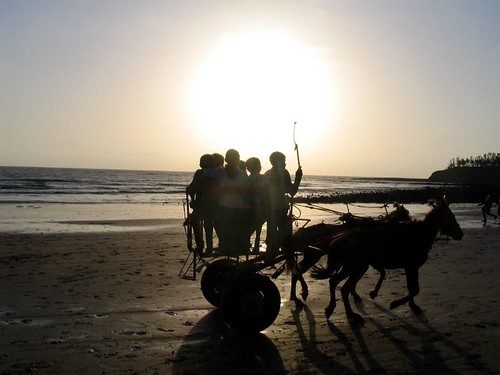
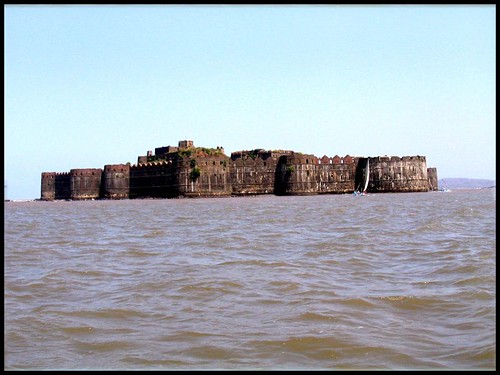
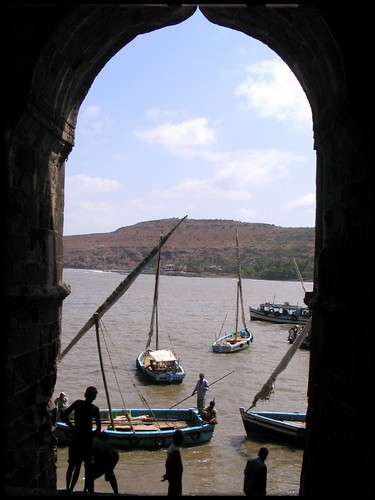




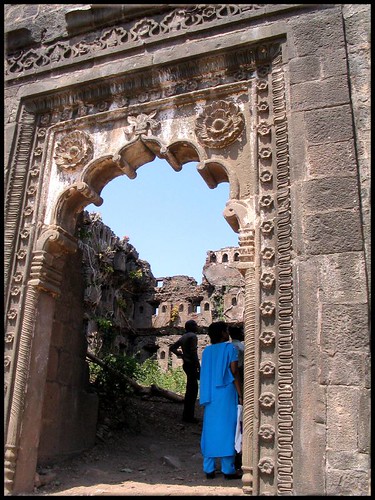


What a lovely, informative write up! I didnt even know about this place till you mentioned it. So wonderful to read your post. Keep writing.
Great writing and beautiful photos. You transported me to these places. Thanks.
Thanks to you, I can be a desktop traveller par excellence!
I have been to all these places and you refreshed my memories.
Thanks.
We visit Murud very often and stay right on the beach … it is our medicine for tired souls 🙂 Usually stop at Kashid for around an hour or so. We usually avoid guides as they tend to rush and make up most stories.
Lovely snaps Charu! 🙂